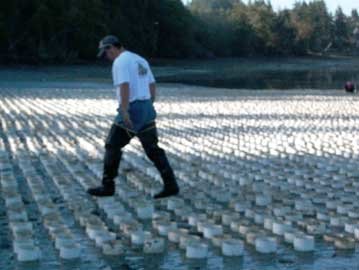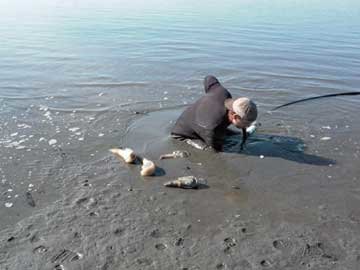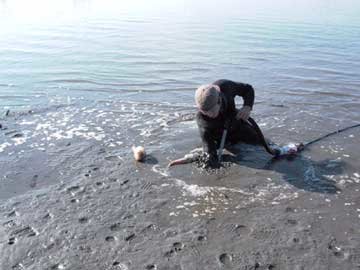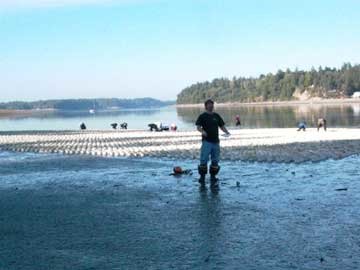[et_pb_text admin_label="Chris Fitzgerald byline; remember to tag post as various-contributors" saved_tabs="all" background_layout="light" text_orientation="left" header_font="Arimo||||" text_font="||on||" use_border_color="off" border_color="#ffffff" border_style="solid"]
Taylor Shellfish Farms in Shelton, the largest aquaculture grower in Washington state, farms 9,000 acres of owned and leased private tidelands in Puget Sound and Willapa Bay. Their new $3.5 million, 22,000-square-foot processing plant “provides capacity for growth,” according to owner Bill Taylor.
“Geoduck is a very sustainable product,” Taylor said. “The same beds are in as good or better condition than when we began (farming them). No chemicals are used. Clean water is more a function of society than shellfish farming.”
 Planting in process at a Stretch Island site. Tubes just buried are stable enough to walk across; nearly 2/3 of the tube is below sand and already home to three tiny geoduck "seeds." Photo by Chris Fitzgerald
Planting in process at a Stretch Island site. Tubes just buried are stable enough to walk across; nearly 2/3 of the tube is below sand and already home to three tiny geoduck "seeds." Photo by Chris Fitzgerald
Yet, he acknowledges, “We don’t know anything specifically about growing geoducks.” His family’s shellfish business is 110 years old, so they “just assume it works.” “Clam planting/harvesting rotations may actually improve and ‘open up’ the beach, letting it breathe; like aerating your yard,” he said.
Taylor Shellfish is investigating state-owned intertidal leases at multiple locations, including Key Peninsula. They represent the Souers’ family Mayo Cove geoduck farm application that is still awaiting a hearing and is the cause of local controversy (see previous story in the August KP News at www.keypennews.com).
Olympia-based Seattle Shellfish, owned by Jim Gibbons, has “yet to earn a dime” for individuals who invested $5 million startup dollars 10 years ago, according to Gibbons. Regardless, Gibbons is actively pursuing more leases.
“What the geoduck industry looks for is clean, sandy intertidal lands,” he said. “The problem — or opportunity — facing Key Peninsula residents is the fact that most peninsula beaches are sandy, and ideally suited for geoduck farming.”
 Not much larger than a short length of hose, the harvest wand shoots only air and is controlled by its holder at all times. Photo by Chris Fitzgerald
Not much larger than a short length of hose, the harvest wand shoots only air and is controlled by its holder at all times. Photo by Chris Fitzgerald
To date, according to Gibbons, geoduck farming occupies only three-quarters of a mile on the Key Peninsula shoreline. To those alarmed about this aquaculture, Gibbons said, “It may seem like rapid growth, but it’s nothing compared to what it could be. In terms of trade deficits per item, the first is oil, the second, seafood. We import far more than we produce. I feel good delivering a renewable product (to the market) for export.”
He, too, acknowledged the lack of science surrounding this crop. “Anything we (the industry) have is anecdotal. Intertidal geoduck aquaculture has not been analyzed,” he said.
Dave Hervey, retired Boeing engineer living on Stretch Island, has leased tidelands to Taylor Shellfish since 1998, experiencing three planting cycles and two harvests. “A farmer has to be a good steward of the land to get a good crop,” he said. “And I like the looks of the tubes. (It) shows something is going on here — each farming (crop) method requires different procedures.”
Hervey’s recently harvested geoduck fields are being replanted. During a recent visit to the site, Brian Phipps, Taylor Shellfish Geoduck project manager, noted Hervey’s upland beaches, strewn with kayaks, beach equipment, crab pots — evidence of shoreline use and enjoyment. Hervey says his family experiences no negative impact from farming whatsoever.
 Not much larger than a short length of hose, the harvest wand shoots only air and is controlled by its holder at all times. Photo by Chris Fitzgerald
Not much larger than a short length of hose, the harvest wand shoots only air and is controlled by its holder at all times. Photo by Chris Fitzgerald
Taylor, Gibbons, and Phipps all voiced frustration by organized opposition’s use of old photos and references to what they term the illegal Purdy Spit geoduck fiasco, which was in the spotlight a few years ago. They say if their industry were permitted to clean up the spit, debris would have been contained and removed. Instead, Pierce County charged itself with cleanup, and accepted no offer to assist, they said. They all agree the site is “still a mess.”
Gibbons, Taylor, and Phipps know people don’t want to look at planting tubes; the industry is investigating alternatives suitable to aquaculture. And debris is an on-going issue addressed daily.
“Our crews clean up these beaches (whether it’s our debris or not),” said Phipps. “We’ve hauled away hundreds of washed-up tires, truckloads of garbage. We have a lot of equipment in these beds; we definitely want it all back.”
Gesturing across the North Bay to houses crowded along the uplands, Phipps wonders aloud about pollutants trickling from yards, gardens, septic systems. “I think anybody who is interested in leasing (or opposes it) should see a farm,” he said. “It’s not for everybody; people should be able to do what they want with private property.”
As Jesse Vincent tended the garden for Dr. Fred McFeely on a pleasant plot overlooking tidy oyster, clam and geoduck beds below, visible at a relatively high low tide (4 foot minus), Phipps walked by on his way from the beach. McFeely has been doing business with Taylor Shellfish for four years in shellfish, with geoduck beds planted one month ago. The beds on his beach are clean, low to the ground, and set with geometric precision. The geoduck are seeded three to a white PVC tube protruding 3 to 5 inches above the sand, covered with black nylon nets held by surface-level rebar hooks to protect the seeds (recognizable geoducks only 1 inch long) from predators. Seaweed has already begun to accumulate; small crabs are present.
 Seasonal workers plant the last rows in a recently harvested field and begin to blanket the seed tubes with strong nylon netting. Photo by Chris Fitzgerald
Seasonal workers plant the last rows in a recently harvested field and begin to blanket the seed tubes with strong nylon netting. Photo by Chris Fitzgerald
McFeeley reports Taylor Shellfish Farms crews regularly check beds; he is pleased with the working relationship. “The world is changing,” he said. “Thirty years ago, we wouldn’t think of having something like this. We can’t go back.”
His waterfront along State Route 302 has been in the family since 1932. Most of his neighbors also have some kind of aquaculture on their beaches, and he recalls no opposition to his decision. “It’s my land anyway,” he said.
After a mid-August meeting with potential lessees and groups opposing geoduck farming on the Key Peninsula, Phipps is hopeful for an amicable compromise.
“I think we worked together well,” said Laurie Brauneis of Save Our Shoreline!, one of the opposition groups. “They (Taylor Shellfish) are the largest grower, setting standards for their industry.”
Brauneis’ group, and several others, spoke with Phipps about farming practices and safety issues. “It’s a fairly new industry,” she said. “They experimented with materials they hadn’t tested, like rubber bands bought at a store.” (Phipps acknowledged the error of using rubber bands and individual tube coverings.)
The groups as a whole would like an Environmental Impact Study done on the industry. “Aesthetics and debris are just part of it — there is no science on long-term effects to near-shore habitat,” she said. “I can’t have a gravel pit on my property, create dust and noise, but that doesn’t seem to apply to the beach.”
She contends shellfish companies talk about single farms but attempt to acquire leases down a shoreline to consolidate resources and man-hours. Brauneis attended a presentation Gibbons made, and said, “It didn’t include the harvest. The topography of the beach goes back to its natural state in two tide cycles, but what about the ground 3 feet down?”
She notes there were no photos of harvest at the recent Taylor Shellfish Farms booth at the Key Peninsula Fair. When asked about this omission, Taylor replied, “I didn’t see the booth. Harvest isn’t a big part of the process.” He said there is a wide range of techniques used to harvest (different) shellfish. “To us, it’s no big deal,” he said.
UNDERWRITTEN BY THE FUND FOR NONPROFIT NEWS (NEWSMATCH) AT THE MIAMI FOUNDATION, THE ANGEL GUILD, ADVERTISERS, DONORS AND PEOPLE WHO SUPPORT INDEPENDENT, NONPROFIT LOCAL NEWS